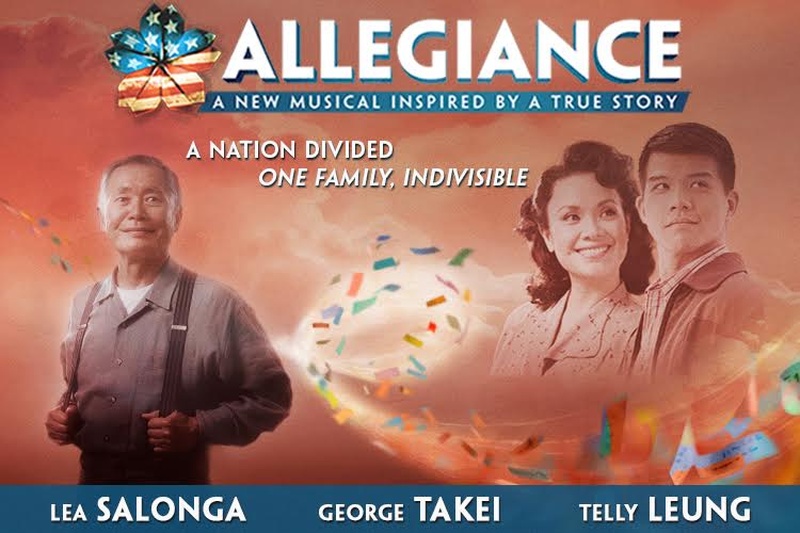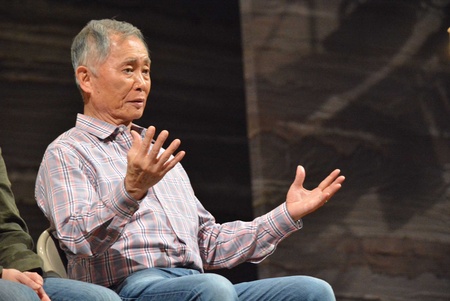After a November performance at the Longacre Theatre in New York’s fabled Broadway district, AARP members were invited for a “talkback” with George Takei and other cast members answering questions about their powerful musical, Allegiance. (NOTE: This post was originally uploaded to the AARP AAPI Community Facebook page.)
“I remember we started the school day, each day, with the Pledge of Allegiance to the flag. I could see the barbed wire fence and the sentry tower right outside my school house window as I recited the words, ‘with liberty, and justice for all.’”
Takei recalled his experience as a child, sent with his entire family to a concentration camp along with more than 110,000 people of Japanese descent—including, like Takei, half who were born in the US and therefore American citizens—during World War II.
Now, at age 78, Takei is pledging again, making his Broadway debut in Allegiance, which tells the story of Japanese American incarceration inspired by Takei’s childhood. The parallels between the 1940s incarceration and the national mood today are striking. The news is filled with politicians speaking out against accepting refugees from the Middle East, and some are stoking a palpable fear within the public over Muslims.
Takei has spoken out eloquently on his vast social media networks in response to the hate-filled climate—he even invited David Bowers, the mayor of Roanoke, Virginia to come see a performance of Allegiance after the mayor announced he didn’t want any Syrian refugees in his city, and cited the Japanese American incarceration as a model. The mayor said the threat from ISIS via refugees is “just as real and serious as that from our enemies then.”
Takei criticized the mayor for his “galling lack of compassion” and added, “…one of the reasons I am telling our story on Broadway eight times a week in Allegiance is because of people like you. You who hold a position of authority and power, but you demonstrably have failed to learn the most basic of American civics or history lessons. So Mayor Bowers, I am officially inviting you to come see our show, as my personal guest. Perhaps you, too, will come away with more compassion and understanding.”
Educating the public about what happened to Japanese Americans during World War II, when 120,000 people of Japanese heritage (half were US-born American citizens) were removed from the West Coast and sent to nine concentration camps as far east as Arkansas, is one of Takei’s lifelong goals. His family spent the war years in Rowher, Arkansas.
“I’m always shocked when I tell the story (of Japanese American incarceration) to people that I consider well-informed,” he said, “and they’re shocked and aghast that something like this could happen in the United States. It’s still little-known. So, it’s been my mission to raise the awareness of this chapter of American history.”
Allegiance accomplishes Takei’s goal with Broadway grandeur that matches any hit musical, with songs that soar and tug at heartstrings, tight choreography, and a storyline that is familiar to many Japanese Americans, but not to the public at large.
The script follows the life of Sam Kimura, with the opening scene featuring Takei as an aged Kimura learning that his sister has died. Then the narrative flashes back to pre-war California, where the Japanese American community thrived, until Japan attacked on Pearl Harbor. The play shifts to the emotional and cultural ties that bind families together—and sometimes tear them apart.
During the prewar scenes and when the Kimura family was imprisoned at Heart Mountain in Wyoming, Takei plays the role of the grandfather, who remains a wise blithe spirit in spite of the family’s hardships. The young Sam Kimura is played by Telly Leung. Lea Salonga, best-known for her Tony-winning lead role in Miss Saigon, plays the young Sam’s sister Kei.
The war and imprisonment split Japanese Americans in general, especially over a “Loyalty Questionnaire” that everyone in the camps was required to answer. Two questions set up the split, by asking if the person would foreswear loyalty to the Emperor of Japan (the vast majority weren’t loyal to Japan in the first place), and if the person would be willing to fight in the US military. Most Japanese Americans chose to answer “yes” and “yes” but some insisted that the imprisonment was wrong, and answered “no” and “no.” The “No-No Boys” were singled out as bad seeds and sent to a camp in Tule Lake, California.
Toward the end of the war, the US needed more soldiers and used the answers from the Loyalty Questionnaire to recruit men for the mostly Japanese American 442nd Regimental Combat Team, which was paired with the Hawaii-based 100th Battalion and together became the single most decorated unit for its size and length of service in the history of the United State military.
Sam Kimura chose to be one of these soldiers, even though his family was imprisoned stateside. The man Lea Salonga falls in love with became a No-No Boy—Frankie Suzuki (played by Michael K. Lee) fights the government’s treatment of Japanese Americans. The dynamics are stark and tense, but also believable; this happened to many Japanese American families.
The production is not only Takei’s Broadway debut; it’s a historic musical because it’s the first to ever make it to the Great White Way with a mostly Asian American cast, and Asian Americans behind the scenes as director, producers, writers, and composer. It’s not a view of Asians through a white perspective (Miss Saigon, Pacific Overtures). It’s an Asian American story told by Asian Americans.
And the play came about through a chance meeting. It’s as if it was karma for Takei to bring this story to the stage.
In 2008, Takei and his husband Brad were at a Broadway musical when they met a pair of fans in the row in front of them. The two were Jay Kuo, a writer and composer, and co-lead producer and writer Lorenzo Thione. Kuo recognized Takei’s deep voice and turned around and introduced himself.
The next night, the four happened to attend a different play, In the Heights by Lin-Manuel Miranda, whose current hit Hamilton is the hottest ticket on Broadway. (Miranda has been a very vocal supporter of Allegiance and has even made a fun video with the Allegiance cast singing Gaman in front of Hamilton.)
Looking across the theater, said Takei in an interview, “There were two arms waving at us, and it was Lorenzo and Jay again. Brad said I think they’re stalking us. The play was about a Puerto Rican family in New York struggling to make it. There was a powerful song near end of the first act, ‘Useless,’ that reminded me of a teenaged me talking to my father. I began to bawl. Jay and Lorezno asked me why and I shared my story. Jay said it has to be a musical.”
“I think it took a voice like George’s that carries with it that much credibility and authenticity,” recalled Kuo of that second chance meeting. “I knew when he was telling me, I got goosebumps.”
*This article was originally published on Nikkei View, on December 7, 2015.
© 2015 Gil Asakawa








